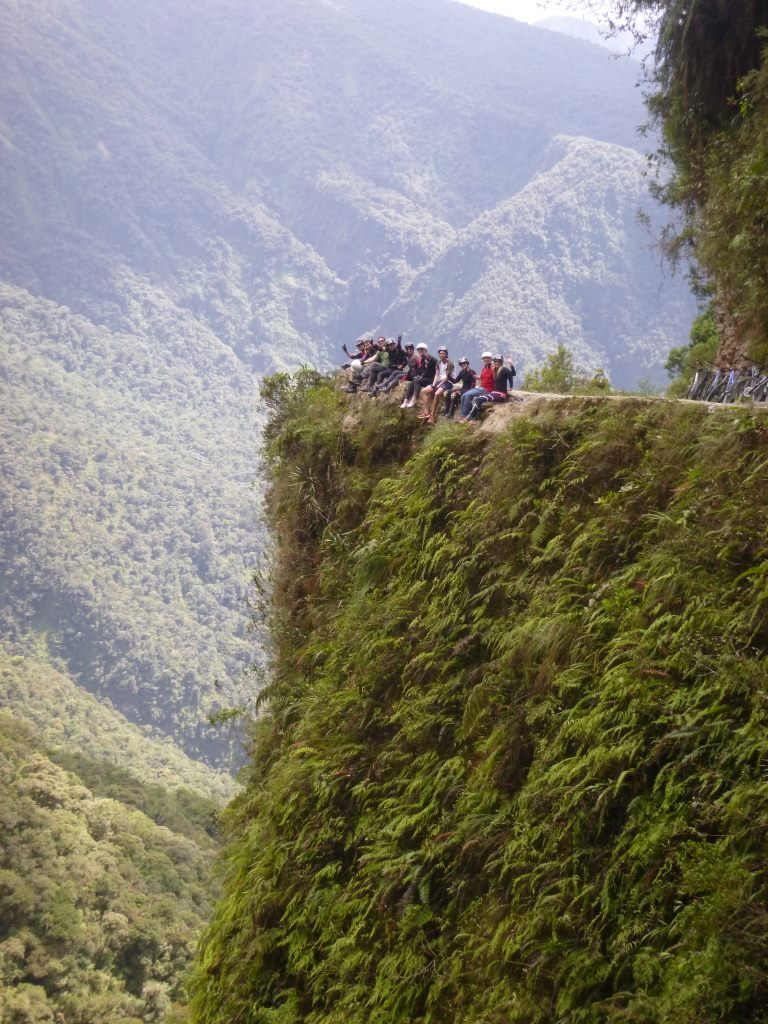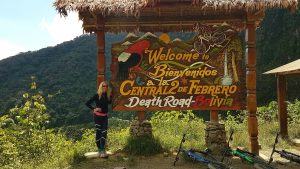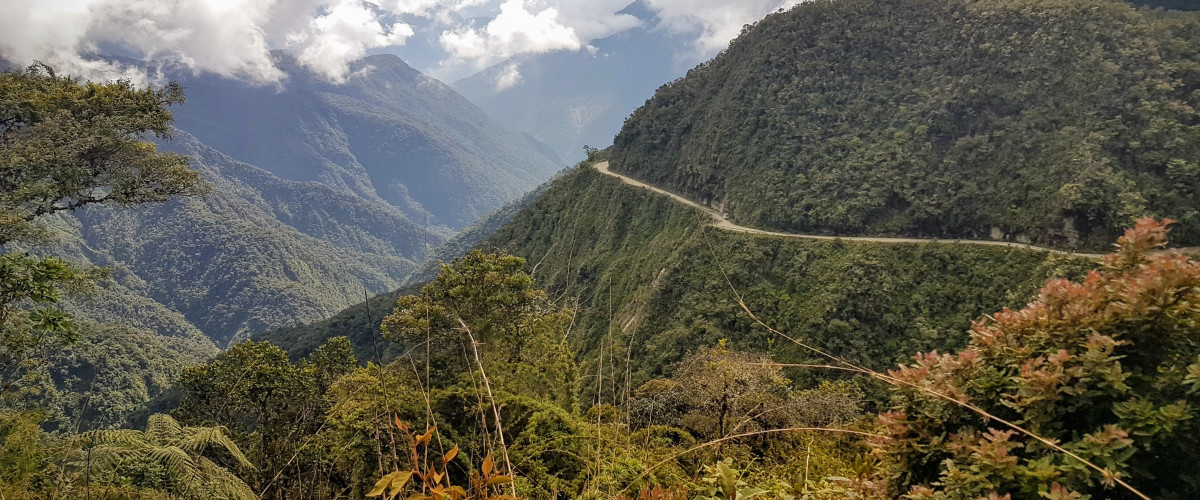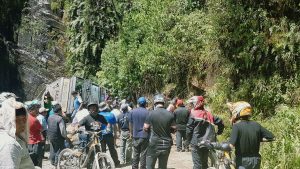This really isn’t ‘the world’s most dangerous road’ – at least not anymore. It was named by the Inter-American Development Bank when around 300 deaths a year occurred by vehicles toppling over the edge on its hairpin bends. On one side there is a 300 ft drop the valley below, on the other, a sheer rock face dribbling with waterfalls. Since the new road was built, Death Road is mostly used for mountain biking and the death toll is significantly lower.
 Despite this, I couldn’t sleep the night before because I’d convinced myself that I was going to be the one who would cycle over the edge and fall 300 ft to a certain death. If Google is correct, 22 people cyclists have been killed on Death Road since 1998, so 1.1 person a year. This is among the many thousands who cycle the road each year and live to tell the tale so statistically my chances were good.
Despite this, I couldn’t sleep the night before because I’d convinced myself that I was going to be the one who would cycle over the edge and fall 300 ft to a certain death. If Google is correct, 22 people cyclists have been killed on Death Road since 1998, so 1.1 person a year. This is among the many thousands who cycle the road each year and live to tell the tale so statistically my chances were good.
I booked my bike ride with Gravity Assisted Mountain Biking who are one of five companies legally registered to operate on the Death Road. They are certainly not the cheapest – and perhaps this is an expensive excursion for what it is – but for your dollars you can be sure that you will be on a well-maintained, full-suspension Kona mountain bike with, most importantly, brakes that work.
Our trip began with two minute lesson on mountain biking and a toast to the Goddess Pachamama with a swig of something like pure meths. There were four Swiss people in my group – two were Italian Swiss, one was French Swiss and one was German Swiss; they all spoke to each other in English (this made me chuckle).
The first part of the ride is lovely downhill on a tarmac road with huge sweeping curves, so you can go very very very fast, which I did. Most bicycle accidents, in fact, happen on this section. I went at full pelt, passing by the American chap in my group. (I wouldn’t want to make an offensive judgements on the fragility of certain male egos but a few minutes later her came steaming past me, and ensured for the rest of the trip he was in front).
A little way into Death Road, we learnt that, due to a landslide on the new road, Death Road was being used by vehicles (normally there are only about one or two sharing the road with cyclists). This made the ride a little more challenging as we made way for cars, motorbikes, lorries, the occasional bus – some crawling their way up, but for the most part hammering up with full force on the throttle. I assumed, in some of the clapped out and over laden cars, this was absolutely necessary to get the car up, but there were times that I wondered what on earth goes though the mind of someone driving like a maniac on a single dusty track edged with a sheer 300ft drop.
About a quarter of the way down we heard that a lorry had overturned and vehicles were unable to get through. As we arrived at the scene of the accident, it was clear it was pretty serious. The lorry had overturned on a hairpin bend and shed its load of wood over the cliff edge. There was no room for vehicles to get through and traffic jam was soon piling up on both sides. I couldn’t see a logical way out of the situation – but luckily the Bolivians could. The road needed to be made wider of course (!). So a group of men armed with sledgehammers and pickaxes started hacking away at the cliff. Part of me admired the pragmatism of the Bolivians and their ability to crack on a solve the problem, but really, was this safe? People looked up the cliff nervously; this could all go horribly wrong.
But it didn’t! The road was widened, the traffic started flowing, all was good except us cyclists were being chased down the road by huge thundering lorries, kicking up flumes of dust. By the last section on the road, most of the piled-up traffic seemed to have passed us and the lovely swerving downhill was joyous. On one side there are towering rocky cliffs, on the other a 300ft drop. The scenery is beautiful – lush Amazonian jungle covering the steep sides of the canyon. We arrived at the bottom parched and covered from head to foot in dust.
 Our trip ended at an animal sanctuary where we ate, drank beer and went on little tour to see two Spectacled Bears. (As this is the only native bear of Bolivia and Peru, I was happy to learn that Paddington is probably a Spectacled Bear.)
Our trip ended at an animal sanctuary where we ate, drank beer and went on little tour to see two Spectacled Bears. (As this is the only native bear of Bolivia and Peru, I was happy to learn that Paddington is probably a Spectacled Bear.)
We were initially told we would have to drive back up Death Road due to the landslide but luckily, just at the last minute, we had a call to say the new road had reopened. I can’t explain how relieved I was – Death Road got its name from the 300+ deaths a year from vehicles going over the edge; cycling is a doddle in comparison.
On the trip home we saw the remains of the landslide on the new road – a rock the size of a lorry was still on the road. Landslides are serious stuff here in Bolivia, a car in its path wouldn’t have stood a chance.
It was an exhilarating day. I very nearly didn’t do the Death Road cycle but reminded myself that you usually regret the things you don’t do in life rather than the things you do.


